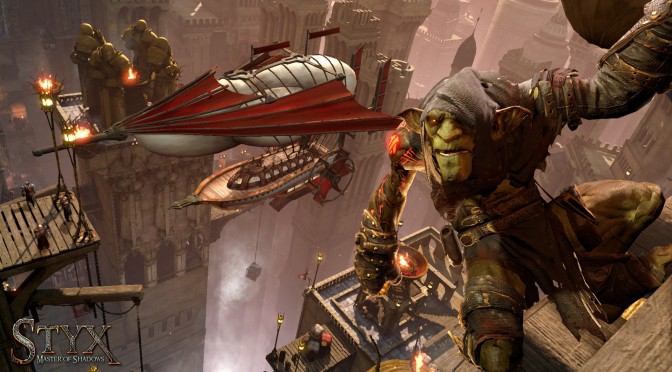We’ve been covering Styx: Master of Shadows extensively lately, so time now to take a look at this new infiltration/stealth game that’s developed by Cyanide and published by Focus Home Interactive. As with all games of Cyanide, Styx: Master of Shadows is not a demanding title. While the game scales well on multi-core CPUs, it doesn’t require a high-end one to shine. And in true classic Cyanide-style, it sports average visuals that will not ‘wow’ you.
But that’s to be expected from a small studio. Obviously Cyanide does not have the manpower or the means to create a new Crysis or Battlefield game. So there is no real reason to be harsh on the game’s technical area. Styx: Master of Shadows looks like most old-gen multiplatform games; it packs blurry textures, average-ish characters and a lighting system that feels quite dated for today’s standards. Moreover, we were surprised by the lack of ambient occlusion, which obviously resulted in some really ugly, blurry and flat scenes.
Styx: Master of Shadows is described as an infiltration game with RPG elements. As such, the game’s stealth gameplay mechanics are essential to its success, and we are happy to report that most of the times, Styx: Master of Shadows feels like a great stealth game. That’s mostly to the ‘above-average’ enemy AI, which can be easily tricked in order to provide alternative routes to your objectives.
For example, take a look at the end of our video. Before entering the last room, we left a dead body nearby. While approaching the exit of that room, one of the guards took notice of it, alerting his other comrades, and that gave us the opportunity to sneak by and pass unnoticed.
Styx: Master of Shadows is almost everything stealth fans could expect. Styx can roll, crouch, hide in the shadows, extinguish torches, climb walls in order to gain access to new areas via which they can approach their objective, and more. On paper, everything should work fine in this game. However, there are some things that put us off while playing Cyanide’s title.
Our main issues with Styx: Master of Shadows are the character itself, the level design, and the enemy cone of vision. Styx is not an interesting character – at all – and the game’s storyline seemed uninspiring. In addition, the enemy line of sight felt weird. On a number of occasions, enemies were not able to notice us with their peripheral vision. And since you will be unable to determine whether an enemy can see you or not, you will have to resort – some times – on ‘trial & error’ tactics.
But perhaps the biggest issue with Styx: Master of Shadows is its level design. As we already said, we found Styx a really bland character; a character for which we did not really care. But that could have been saved if the levels were interesting enough to intrigue us. Unfortunately, the game’s levels are not that impressive. Like the main character, they feel bland, soulless, generic, and uninteresting to explore.
All in all, while Styx: Master of Shadows packs the means to be a really good game, it seriously falls behind due to various shortcomings. Styx isn’t a character for which you will really care about, the storyline and voice acting won’t draw you into the world of the game, and the level design is not that inspiring. Stealth fans should obviously give it a go as it’s been a while since we got a ‘pure’ and ‘proper’ stealth/infiltration game, however Styx: Master of Shadows could have been so much more!

John is the founder and Editor in Chief at DSOGaming. He is a PC gaming fan and highly supports the modding and indie communities. Before creating DSOGaming, John worked on numerous gaming websites. While he is a die-hard PC gamer, his gaming roots can be found on consoles. John loved – and still does – the 16-bit consoles, and considers SNES to be one of the best consoles. Still, the PC platform won him over consoles. That was mainly due to 3DFX and its iconic dedicated 3D accelerator graphics card, Voodoo 2. John has also written a higher degree thesis on the “The Evolution of PC graphics cards.”
Contact: Email

